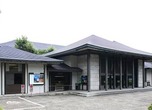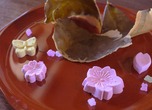
Kiyokata no ma ‘Samugae Jionji Temple's hina doll’
Posted: Tue Feb 16 2010
A series of seven rooms connected by a hyakudan (100 steps) stairway passage, Meguro Gajoen’s Hyakudan Kaidan is a designated Tangible Cultural Property. Usual visits are restricted by special limited appointment, but to commemorate the upcoming dolls’ festival or hina-matsuri on March 3, ‘Hyakudan Kaidan’ is throwing a party of its own: the ‘Hyakudan Hina-matsuri’.
Bringing together a collection of Edo period hina dolls passed down through generations of Yamagata aristocracy, the festival has generated much buzz for both its extraordinary setting and rarity of the precious hina dolls displayed. Yamagata is said to be home to many of the most sumptuous hina dolls in Japan, and the majority on exhibit have never been seen outside the homes of their respective owners.
Setting the scene, visitors are absorbed into the raden (mother-of-pearl inlay) lift which serves as the venue’s entrance. Shoes left at the entrance, the exhibition starts in the first of the seven rooms: the ‘Jippo no ma’. Introducing the history of and types of hina dolls, this room allows visitors to get up close and personal with the dolls which are displayed entirely in the open. The atmosphere is relaxed – no doubt somewhat to the absence of stuffy glass Perspex cases – with visitors welcome to linger and appreciate the appearance of rarer styles. A unique characteristic of this exhibition is that each of the Hyakudan Kaidan’s seven rooms bears a different theme, and after gaining a fundamental knowledge of all things hina in the ‘Jippo no ma,’ it’s finally time for the nitty gritty of the curated collection.
In each of the seven rooms of the ‘Hyakudan Kaidan’ - even the room decked out with the most splendid and elaborate wood engraving, vivid lacquerwork and pure gold leaf - the hina dolls don’t fade into the background: both the dolls and their settings command an equally brilliant presence. Take for instance the ‘Gyosho no ma,’ which displays the Kokin hina, owned by the venerated Kato family from Sakata. The room contains eleven dolls from the Kato collection, which boasts some of the largest hina dolls in Japan. A supreme achievement in craftsmanship, the Empress doll measures 40cm and the Emperor 43cm.
The ‘Kiyokata no ma’ is just as magnificent, its hina doll display from the Japanese restaurant Jionji Temple in Sagae. The space is divided into a back and a front room: the back housing the dolls on a vermillion hinadan (the traditional tiered, red carpeted stand) and the front a space where visitors can sit and view them. Kiyotaka Kaburaki’s ephemeral bijinga (images of beautiful women) winter scene, contrasting with approximately 30 hina dolls and a multitude of accessories, leaves one absolutely breathless.
To realise Hyakudan Hina-matsuri’s fruition, exhibition curators made many trips to Yamagata to meet the dolls’ individual owners. Not only did the fragile hina dolls need to be transported over long distances, but the potential impact of climate difference between Yamagata and Tokyo also needed to be considered. Yet with understanding from those families who had carefully passed down hina pieces from generation to generation, the exhibition was able to proceed. With fewer and fewer families displaying dolls for hina matsuri, the overall conservation of Japan’s hina culture is a matter needing to be given serious thought. Observing how these families from Yamagata have carefully preserved hina culture, presented within the resplendent confines of Hyakudan Kaidan, a solution just may be found.
Tokyo Designated Tangible Cultural Property
‘Hyakudan Kaidan’ Special Event
‘Hyakudan Hina-matsuri’ Yamagata Hina Kiko at Meguro Gajoen
Venue: Meguro Gajoen, Tokyo Designated Tangible Cultural Property ‘Hyakudan Kaidan’
Date: Until Wed Mar 3
Time: Daily 10am–6pm (last entry 5.30pm)
(special evening tour available (5.45–8pm. Includes guided commentary and meal. Numbers are limited, pre-booking required))
Price: ¥1,500, ¥1,200 advance. Children under primary school age free.
Telehone: (03)5434 3140 (Meguro Gajoen)
Website: megurogajoen.co.jp/event/hinamaturi/
Related articles
・Tokyo’s top 12 Ume spots
Plum blossom season is short: don’t miss out
・Area Feature: Shibamata
A blast from the Showa past
・Traditional Japanese theatre: overview
Tokyo's stages bring on the best
Tags:
Tweets
- About Us |
- Work for Time Out |
- Send us info |
- Advertising |
- Mobile edition |
- Terms & Conditions |
- Privacy policy |
- Contact Us
Copyright © 2014 Time Out Tokyo












Add your comment